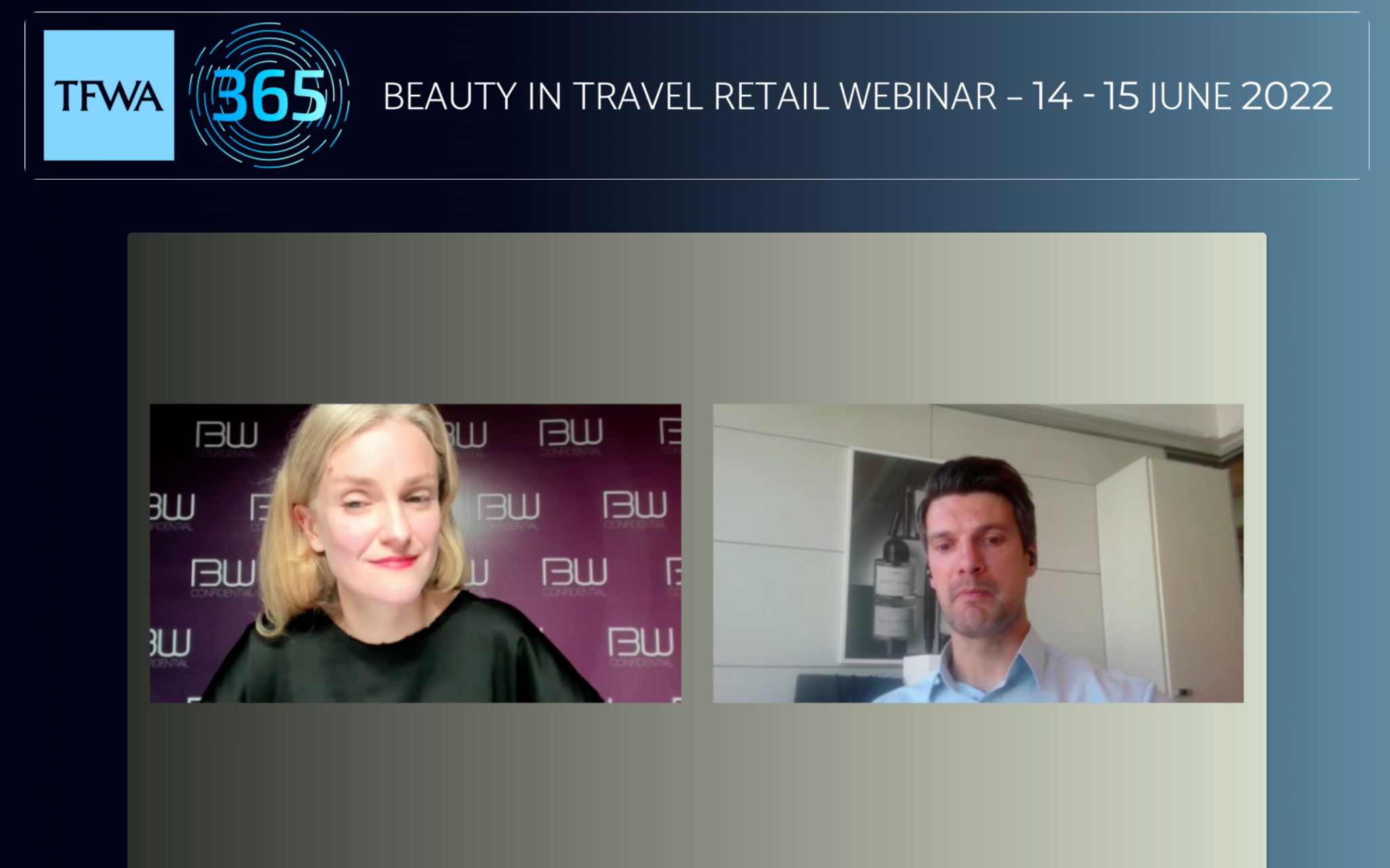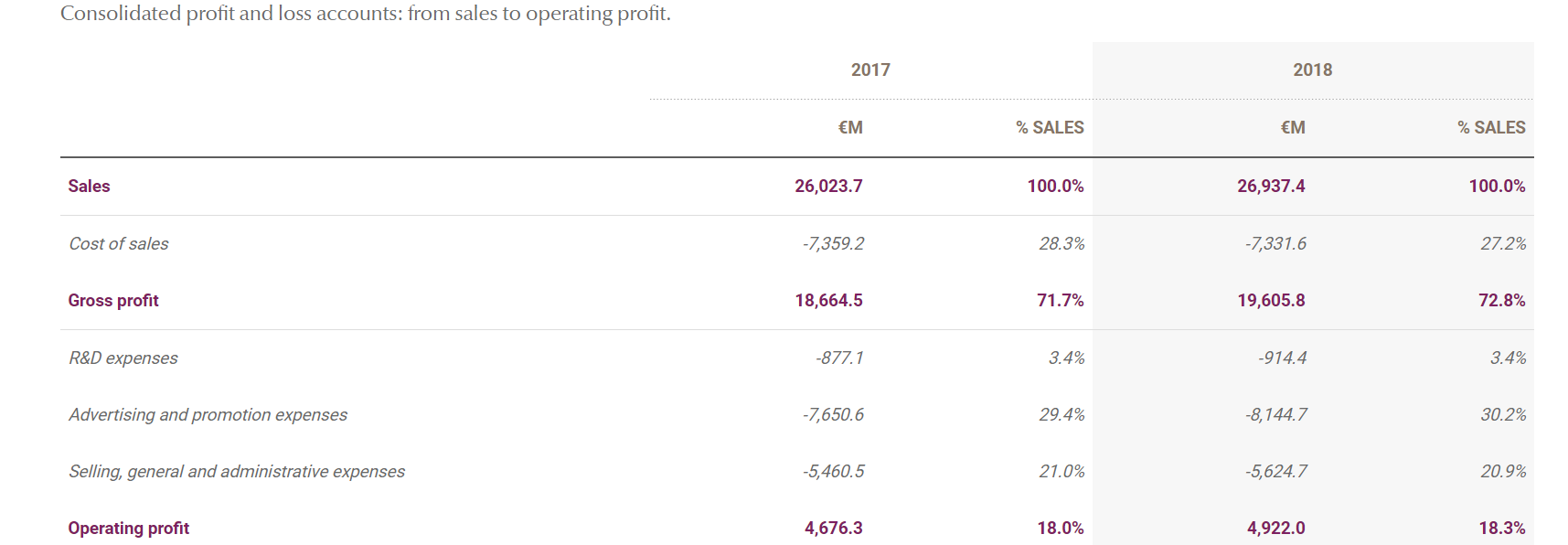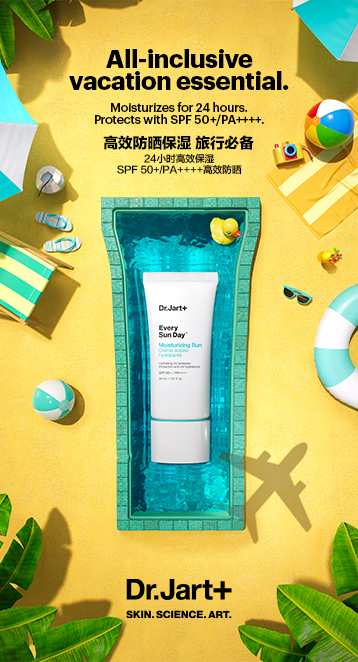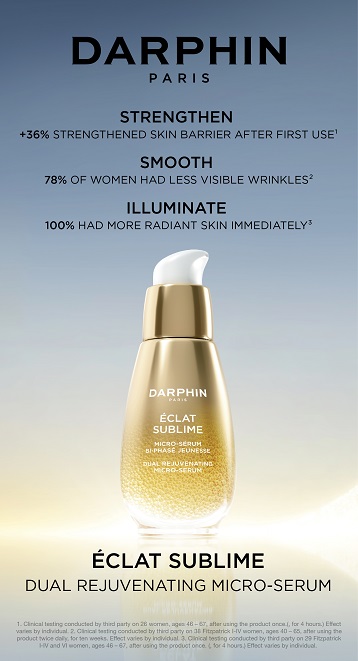
The Tax Free World Association (TFWA) partnered with BW Confidential and Gebr. Heinemann to host the ‘Beauty in Travel Retail’ webinars on 14-15 June. The webinar sessions explored key issues facing the perfumes & cosmetics category in travel retail.
The webinars, hosted on the TFWA 365 online platform, were moderated by BW Confidential Editor in Chief Oonagh Phillips and TFWA Conference Manager Michele Miranda.


The line-up for day one comprised NPD Group Vice President and Beauty Industry Advisor Larissa Jensen; SpaceNK CEO Andrew Lightfoot; Gebr. Heinemann Head of Category Management Jan Binke and Puig Vice President of Global Travel Retail Kaatje Noens.
During her presentation, Jensen outlined the biggest consumer trends that will influence the category. She was followed by Lightfoot who talked about SpaceNK’s wholesale+ model and how the online/wholesale retailer is adapting to meet changing consumer needs. He highlighted the early pandemic shift from personal fragrance to home fragrance and how the former is coming back with a vengeance.
Binke gave a fascinating overview on Gebr. Heinemann’s key pandemic learnings. According to Binke, the global beauty business grew +7% in the last year, particularly driven by the US and China domestic markets.
The overall beauty category has grown by +14% in European travel retail. Binke reflected Lightfoot’s comments on the power of fragrance. He said that fragrance was the top-performing category globally apart from in Asia.

In 2021, Gebr. Heinemann’s beauty business was -53% below pre-pandemic 2019 levels. In May 2022, this figure rose to just -28% versus the same month in 2019 . The retailer expects this figure to round off to -25% down on 2019 levels by the end of 2022.
“For Gebr. Heinemann, we’ve had satisfying results in 2021 and ambitious goals in 2022 despite the current socio-political climate,” Binke said. “Things are looking better for the second quarter with summer coming up.
“We are always looking for trends and how things are evolving. For example, beauty is currently 71% of 2019 levels, but fragrance is back to 80%. Fragrance has proven to be a resilient category amidst the pandemic and we will be capitalising on this. Skincare is recovering slowly due to the lack of Chinese travellers, but makeup is performing above expectations after a big dip in 2020.”
Binke highlighted price, brand loyalty, sustainability and innovation as the four major consumer trends that will impact the perfumes & cosmetics category in travel retail. In terms of how rising inflation is affecting behaviour, he noted that purchases are being driven to opposite ends of the price spectrum. “Entry level priced products are currently at 91% of 2019 levels year-to-date. In skincare, entry level products are already 4% of the total market share which is why we are testing new price points in 2022.


“On the opposite end of the spectrum, super prestige products and luxury niche fragrances have also performed well. To adapt to this, we expanded our assortment to include 11% of fragrances in 2021. We are also onboarding super-premium beauty brands such as Augustinus Bader into the mix,” he added.
“Brand loyalty has become a major purchase driver in pandemic times with the top 15 SKUs making up 10% of our total B2C turnover. The top eight brands in our stores grew by +7.8% this year. Paco Rabanne Phantom is an excellent example of this and we’re hoping to have more meaningful launches and activations with key suppliers.”
Underlining the importance of channel exclusives, Binke said that the retailer is quadrupling its travel retail-exclusive range from 4% to 12-15% this year. Gebr. Heinemann is also looking for new ways to onboard agile and innovative influencer and high-performance brands into its portfolio.
Noens concluded the webinar by offering a positive view on the recovery of the travel retail beauty and fragrance category. Thanks to the resilience of the fragrance category, Puig has already surpassed 2019 levels this year, she said.

“COVID put everything into question,” she said. “We discovered that we are much more resilient as a category. We learned what people buy into and it’s all about hero products and love brands. 1 Million, Good Girl and Phantom are hero brands.
Puig’s striking Phantom pop-ups propelled the brand to become one of Gebr. Heinemann’s top performers last year. The fragrance company also launched a pop-up for Penhaligon’s that has performed exceptionally well, according to Noens.
“Brands that are willing to take a risk and make a bold statement will see returns. The ticket price is higher and so we’re proud to say we’re already above 2019. This is thanks to our amazing partnerships with retailers and the Paco Rabanne Phantom and Penhaligon’s animations. I think travel retail is the channel that will rise above anything and everything – bigger and better than ever.”
The Next Digital Frontier

Day two of the Beauty in Travel Retail webinar explored beauty’s next digital frontier. The speakers included WITH Consultancy Travel Retail Consultant Xue Guo; L’Oréal Travel Retail Global Retail & Digital General Manager Sophie Neyertz-Ehrsam; Perfect Corp Executive Vice President & Chief Strategy Officer Louis Chen; and Szentia CEO Ignacio Longarte. It also featured Tribe Dynamics Co-founder Conor Begley and Anastasia Beverly Hills Senior Director of Influencer Relations and Social Media Alanah Dixon.

Guo highlighted Puig’s Paco Rabanne Phantom animation, Lancôme and China Duty Free Group’s Chinese New Year activation and Christian Louboutin’s Golden Week campaign as key examples of how digital strategies are being used in Hainan.
She also underscored the value of investment in Chinese social media and partnering with online travel platforms such as Fliggy and Ctrip as key strategies to raising brand awareness and sales in China.
Neyertz-Ehrsam gave a fascinating presentation on how L’Oréal Travel Retail is leveraging digital in 2022. “2021 has been a tipping point in our digital transformation,” she said. “We now have five billion internet users, three billion digital gamers, one billion extended reality users and 400 million crypto holders. 2021 has been a tipping point for utopia cravings, techno-power and the creator economy. We have entered a new era of the internet.”

She added, “In Web 3.0, the new place to meet and hang out is the metaverse. Digital products can be sold and bought and we’re moving from digitalisation to virtualisation. From online+offline to online+offline+on-chain.
“Web 3.0 is a new world of infinite possibilities, immersive experiences and new models of consumer and community engagement – so we need to be ready.”
According to Neyertz-Ehrsam, beauty and digital are the perfect match with the latter transforming the beauty industry in the last ten years. She said: “Today, ecommerce represents 25% of the beauty industry worldwide. Research suggests it will represent 50% of the market in four to five years. Digital media expenses represent 60% of beauty media investment worldwide, showing how brands are committed to reaching consumers at all touchpoints of their journey.


“COVID has been a catalyst for the digital and virtual era,” she added. “We see a very strong acceleration in Asia with digital engagement, livestreaming O+O and metaverse strategies. In the west, we are just at the beginning of the digital transformation.”
Beauty is travel retail’s top category representing 40% of the market pre-covid and 60% in 2020 based on figures from Generation Research. Neyertz-Ehrsam said, “Two-thirds of airport travellers never enter a duty free shop and 82% of them never buy. Even if we just increase penetration, conversion and average basket price by two percentage points – the growth potential is crazy. We need to hack the traveller funnel at every step of their journey pre-trip, in trip and at destination across all omnichannel touchpoints. Digital is the only enabler to make that happen.”


According to Neyertz-Ehrsam consumer engagement, services and experiences, ecommerce acceleration and data are the four key pillars to unlocking beauty’s next digital frontier.
Neyertz-Ehrsam was followed by Chen who outlined the seemingly endless possibilities for beauty companies in the metaverse. According to Chen, 400,000 digital beauty products have already been uploaded into the metaverse. He said, “The metaverse is the natural evolution of the shopping experience. There are plenty of opportunities for brands, including NFT collections, virtual try-on, tokenising and phygital activations.”

Longarte gave a presentation on how brands and retailers can transition to Web 3.0. He said, “The transition will be unique for every brand. Ubiquitous content is king. Interactive and immersive 3D technology, liquidity between channels and decentralised and automated value exchange will be crucial in that process.”
Finally, Begley and Dixon discussed key strategies for brands to grow awareness and engagement on Gen-Z video content platform TikTok.








